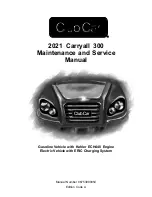
2004 V-Glide 36-Volt Electric Vehicle Maintenance and Service Supplement
Page 13-1
13
SECTION 13 – BATTERIES
∆
DANGER
• See General Warning, Section 10, Page 10-1.
∆
WARNING
• See General Warning, Section 10, Page 10-1.
GENERAL INFORMATION
The batteries supplied with an electric Club Car vehicle are different from those supplied with an automobile.
The outward appearances of these two types of batteries are similar, but the operating characteristics are very
different. The Club Car electric vehicle battery is a deep-cycle battery, and the automotive battery is a “start-
ing, lighting and ignition” (SLI) battery. They should never be substituted for one another.
An automotive battery has to deliver high-cranking currents of 300-400 amperes at a sufficient voltage for sev-
eral seconds and maintain an accessory load of 10-25 amperes in stop-and-go driving. The energy removed
from an automotive battery is immediately replaced by the alternator or generator. As a result, the automotive
battery operates at 90 to 100% of full charge at all times.
The batteries supplied with an electric vehicle must supply 100% of the energy required to operate the vehi-
cle. These batteries therefore, receive a deep discharge down to 30% to 40% of their full charge capacity.
Then they must be recharged, hence the name “deep cycle.” The average amperage draw is considered to be
75 amps on a 36-volt vehicle, although it varies greatly depending on the vehicle and how it is operated. Deep-
cycle vehicle batteries are specifically designed to handle this type of service.
The rechargeable lead-acid battery turns chemical energy into electrical energy and vice versa. The main
active elements within a battery are the positive plates, the negative plates and the electrolyte (sulfuric acid).
Another very important element (but inactive) is the separator. The separator does exactly what its name
implies – it separates the material of the positive and negative plates and prevents them from touching each
other, which would create electrical short circuits. The separator is porous enough to allow charged ions to
pass between the positive and negative plates, but not allow the two materials to contact each other.
Whenever two unlike metals are immersed in an acid solution, an electric current is generated. In a deep-
cycle battery, the negative plates contain lead (Pb) and the positive plates contain lead dioxide (PbO2). These
plates are immersed in a sulfuric acid solution (H2SO4) (Figure 13-1, Page 13-2).
During discharge, the chemical reaction inside the battery causes the sulfate (SO
4
) to break away from the H
2
The sulfate (SO
4
) combines with the lead (Pb) on both plates, forming lead sulfate (PbSO
4
). Oxygen (O
2
)
from the positive plates combines with hydrogen (H) from the electrolyte to form water (H
2
Содержание V-GLIDE
Страница 2: ......
Страница 8: ......
Страница 30: ...11 ...
Страница 48: ...12 ...
Страница 64: ...14 ...
Страница 90: ...16A ...
Страница 104: ...16B ...
Страница 108: ......
Страница 109: ...2004 V Glide 36 Volt Electric Vehicle Maintenance and Service Supplement ...
Страница 110: ......
Страница 111: ......
Страница 112: ...Golf Cars and Utility Vehicles Club Car Inc P O Box 204658 Augusta GA 30917 4658 ...













































